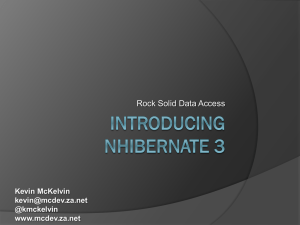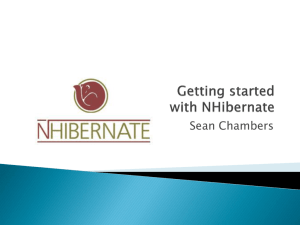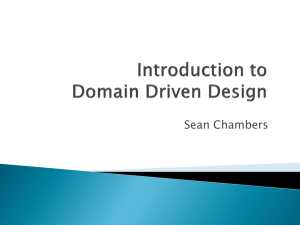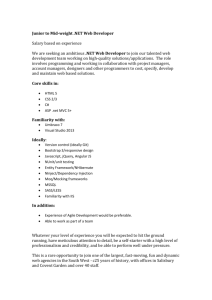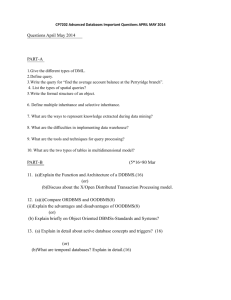AgileDevWithIoCAndORM
advertisement
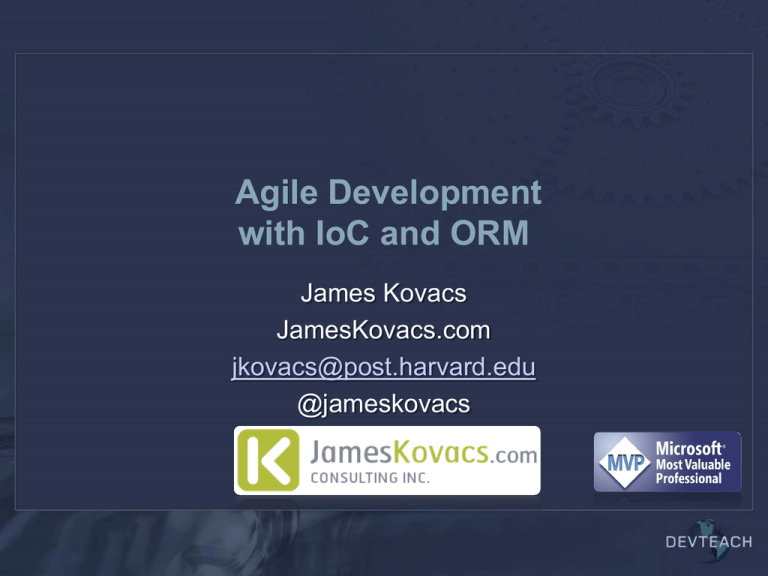
Agile Development
with IoC and ORM
James Kovacs
JamesKovacs.com
jkovacs@post.harvard.edu
@jameskovacs
QUICK SURVEY
INTRODUCTION TO IOC
Dependency Inversion
• High-level modules should not depend on low-level
modules. Both should depend on abstractions.
» Robert C. Martin
Dependency Injection
• Dependencies are provided to objects via constructor or
properties
Constructor injection
Setter injection
• Prefer constructor injection for required dependencies
• Prefer setter injection for optional dependencies
Lab: Poor Man’s Dependency Injection
• Create a CustomerService that
depends on a
CustomerRepository
• Use Poor Man’s to wire them
together
Inversion of Control Containers
• Hashtable of interface vs. implementing type
In simplest form, basically:
Dictionary<Type, object>
• Full-fledged containers offer a lot more...
Popular Containers
• Windsor
http://www.castleproject.com/container
• StructureMap
http://structuremap.sourceforge.net
• Spring.NET
http://www.springframework.net
• Unity
http://codeplex.com/unity
• Ninject
http://ninject.org
• Autofac
http://code.google.com/p/autofac
Why Use Popular Container?
• Wider configuration options
XML, code, script
• Lifetime management
Singleton, transient, per-thread, or pooled
• Auto-wiring dependencies
• Run-time configurability
• Plug-ins
Lab: Castle Windsor
• Change your previous lab to
use Castle Windsor
One Assembly to Rule Them All
• Common Service Locator
http://www.codeplex.com/CommonServiceLocator
public interface IServiceLocator : IServiceProvider {
object GetInstance(Type serviceType);
object GetInstance(Type serviceType, string key);
IEnumerable<object> GetAllInstances(Type serviceType);
TService GetInstance<TService>();
TService GetInstance<TService>(string key);
IEnumerable<TService> GetAllInstances<TService>();
}
Resources
• Loosen Up: Tame Your Software Dependencies for More
Flexible Apps, MSDN Magazine March 2008
http://msdn.microsoft.com/en-us/magazine/cc337885.aspx
• Bricks and Mortar: Building a Castle, CoDe Magazine
May/June 2009
http://code-magazine.com/Article.aspx?quickid=0906051
• Castle Windsor
http://www.castleproject.org/container/
• The Bookshelf
http://www.jameskovacs.com/blog/TheBookshelf.aspx
INTRODUCTION TO O/RM
OO and Relational Worlds
OO
• Object-based
• Unidirectional
associations
• Pointer from owner
• Inheritance
• Polymorphism
• Many-to-many
Relational
• Set-based
• Bidirectional associations
• FK on owned
• No inheritance
• No polymorphism
• Join tables
NHIBERNATE
NHibernate Quickstart
• Create hibernate.cfg.xml or use app.config
var cfg = new Configuration();
cfg.Configure();
var sf = cfg.BuildSessionFactory();
using(var s = sf.OpenSession())
using(var tx = s.BeginTransaction()) {
var c = s.Get<Customer>(42);
tx.Commit();
}
NHibernate API
Configuration
Class for bootstrapping NHibernate
ISessionFactory
Factory for creating sessions
ISession
Roughly analogous to a database
connection
ITransaction
IQuery
Abstracts underlying transaction
semantics
String-based query API aka HQL
ICriteria
Object-based query API aka Criteria
Patterns in NHibernate
•
•
•
•
•
Data Mapper
Identity Map
Unit of Work
Lazy Loading
And many more from Martin Fowler’s Patterns of Enterprise
Application Architcture
Intellisense for NHibernate
• Drop XSD files
nhibernate-mapping.xsd
nhibernate-configuration.xsd
• Into
C:\Program Files \Microsoft Visual Studio
9.0\xml\schemas
Or
C:\Program Files (x86)\Microsoft Visual Studio
9.0\xml\schemas
Lab: Initial Setup
•
•
•
•
•
•
•
Install Subversion client
Install VisualSVN (optional)
Download from Subversion
Install XSD files
Install ReSharper templates
Install NHibernate Plug-in 1.0
Create empty database
CONFIGURATION
NHibernate Configuration
• hibernate.cfg.xml
• App.config or Web.config
• Run-time
Configuring NHibernate
DEMO
Lab: Configuration
•
•
•
•
Create an application
Reference assemblies
Add a configuration file
Configure NHibernate
MAPPING
Mapping Basics
Class
Definitions
Mapping
Metadata
Database
Schema
Mapping Metadata
•
•
•
•
XML files (hbm.xml)
NHibernate.Mapping.Attributes in NHContrib
Castle ActiveRecord
Fluent NHibernate
ClassMap<T>
Automaps
Mapping, Schema Generation, and Simple Fetches
DEMO
Lab: Mapping
• Create a class with simple
properties
• Map the class using
ClassMap<T>
• Export the database schema
• Insert some data using
session.Save(obj)
• Retrieve the saved data using
session.Get<T>() and
session.Load<T>()
RELATIONSHIPS
Understanding Relationships
• <one-to-one name=“Person”/>
Two tables, Customer and Person, share same PK
• <one-to-many class=“Order”/> inside <set>
Two tables, Customer and Order, with a CustomerId on
the Order table
• <many-to-one name=“Customer”/> on Order
Two tables, Customer and Order, with a FK on Order
pointing back to its parent Customer
• <many-to-many>
Two tables with a joining table
Joining table has two FKs, one to each table
One-to-One Associations
• Use <many-to-one> element
Standard FK in parent table to child table
E.g. Person HAS-A HomeAddress
<many-to-one name=“HomeAddress” cascade=“alldelete-orphan”/>
where HomeAddress is an entity with its own PK
• Avoid <one-to-one> element
Used for two tables that share the same primary key
Typically better mapped using
Inheritance
<many-to-one>
More information in NHibernate documentation
Sets, Lists, and Bags... Oh My!
•
Set
Unordered collection of unique elements
Mapped using Iesi.Collections.Generic.ISet<T>
•
List
Ordered collection of non-unique elements
Mapped using System.Collections.Generic.IList<T>
•
Bag
Unordered collection of non-unique elements
Mapped using System.Collections.Generic.IList<T>
•
Others, though not commonly used
Map (Hashtable or Dictionary<K,T>)
Array
Primitive-Array
IdBag
Cascades
• Tells NHibernate how to handle child entities
• Options:
none – no cascades (default)
all – cascade saves, updates, and deletes
save-update - cascade saves and updates
delete – cascade deletes
all-delete-orphan - same as all and delete
orphaned rows
• Can specify default-cascade in hbm.xml file
Lazy Loading
• Default for associations in NHibernate 1.2+
• Requires open ISession
• Fetching strategies
Select, outer-join
• Avoiding the N+1 SELECT problem
Understanding Inverse=“true”
•
Relational model
Bidirectional associations using one FK
•
OO model
Unidirectional associations using references
•
Bidirectional associations in the OO
Two unidirectional associations with the same data
•
•
•
•
Inverse=“true” tells NHibernate which one to ignore
Prevents duplicate updates of FK
Prevents FK violations
“Which table owns the FK?”
<many-to-one> and <one-to-many> collection
inverse is <one-to-many> collection
<many-to-many>
•
choose either
N.B. Cascades are an orthogonal concept!
Mapping Associations
DEMO
Lab: Collections
• Add a collection to your class
• Map the collection
• Load and save items to the
collection
INHERITANCE
Mapping Inheritance Relationships
Person
-Id
-Name
Customer
Employee
-RewardStatus
-Office
Single table inheritance
• Uses discriminator column
• One table contains all possible columns
• All derived class columns must be nullable
Person
Id (PK)
Name
RewardStatus (null)
Office (null)
Concrete table inheritance
• Table per concrete class with complete columns
• Uses subclass
Customer
Id (PK)
Name
RewardStatus
Employee
Id (PK)
Name
Office
Class table inheritance
• Table per class with diff of columns
• Uses joined-subclass
Person
Id (PK)
Name
Customer
Id (PK/FK)
RewardStatus
Employee
Id (PK/FK)
Office
Mapping Inheritance Relationships
DEMO
Lab: Inheritance
• Add a derived class
• Map the relationship using
concrete-table inheritance
• Save instances of base and
derived types
• Examine the saved rows of
data
• EXTRA: Try mapping with
single-table and class-table
inheritance
QUERYING
Querying
•
•
•
•
•
ISession.Get<T>(id) and ISession.Load<T>(id)
Hibernate Query Language (HQL)
Criteria API
Example Queries
LINQ to NHibernate
Querying with HQL
DEMO
Lab: HQL Queries
• Query for customers:
named is “John”
names begin with “S”
• Query for orders:
shipped to Auburn
placed in the last 6
months
• http://nhforge.org/doc/nh/en/in
dex.html#queryhql
Querying with Criteria
DEMO
Lab: Criteria Queries
• Query for customers:
named is “John”
names begin with “S”
• Query for orders:
shipped to Auburn
placed in the last 6
months
Querying with Examples
DEMO
Lab: LINQ
• Find Addresses in Canada
• Find Customers with
LastName starting with S
Filters, Aggregations, and Projections
DEMO
Lab: Filters, Aggregations, and Projections
• Page through SalesOrders for
all Walter in the database
using a Filter
• Number of addresses per city
• Determine the average tax
paid on all orders
THE LEVEL 2 CACHE
NHibernate’s Level 2 Cache
• Cache providers
Hashtable (testing only)
ASP.NET Cache
Prevalence Cache
Memcache
• Entity cache and query cache
• <property name=“cache.provider-class”/>
NHibernate.Cache.HashtableCacheProvider
NHibernate.Caches.SysCache.SysCacheProvide
r, NHibernate.Caches.SysCache
...
Entity Cache
• Via class or collection mappings
<cache usage=“read-write|nonstrict-readwrite|read-only|transactional”/>
• Via hibernate.cfg.xml
<class-cache/> or <collection-cache/>
• Stores serialized entities, not objects
• Entities in 2nd level cache not shared between sessions
Query Cache
•
•
•
•
•
In hibernate.cfg.xml, cache.use_query_cache=true
Only contains identifiers, not serialized entities
IQuery.SetCacheable(true)
IQuery.SetCacheRegion(string)
IQuery.SetForceCacheRefresh(true)
WRAPPING IT UP
Resources
• NHibernate (http://www.nhforge.org)
• NHUsers Google Group (http://groups.google.com/group/nhusers)
• NHibernate FAQ (http://blogs.hibernatingrhinos.com/nhibernate)
Questions
James Kovacs
JamesKovacs.com
jkovacs@post.harvard.edu
@jameskovacs
